Growing and caring for Chinese cabbage in the open field
Growing Peking cabbage outdoors is not difficult even for novice gardeners. But there are certain secrets that will allow you to grow a vegetable from seeds. The care also includes some features.
Better environment
Peking cabbage cultivation and care is based on the fact that it is a crop that tolerates low temperatures well. Seeds can begin to germinate even at a soil temperature of 4 degrees. But further development cannot take place under such conditions. The vegetable feels great at a temperature of about 18 degrees. In summer cottages, you need to choose a place with sufficient lighting and humidity.
In order for the heads of cabbage to be tied, you need to find the right site in the garden. It is best to plant where carrots, garlic, onions, cucumbers used to grow. Cannot be planted where radish, mustard and all cabbage species have been harvested.
How to grow Peking cabbage in the garden depends on the planting material, but first you need to prepare the soil. Since autumn, the selected area is sprinkled with lime components. In extreme cases, a herbicide can be used. In the spring, the earth is dug up with the introduction of humus or compost.
The secrets of growing Chinese cabbage are associated with planting dates. The best is the period with short daylight hours. When daylight is more than 13 hours, the vegetable begins to bloom and shoot arrows, and the yield is significantly reduced.
A favorable time is considered to be mid-April, the last decade in July and early August. During these periods, daylight hours are less than 12 hours. Most often, varieties suitable for salads are chosen for spring, and in summer you can plant a vegetable in order to form a head of cabbage.
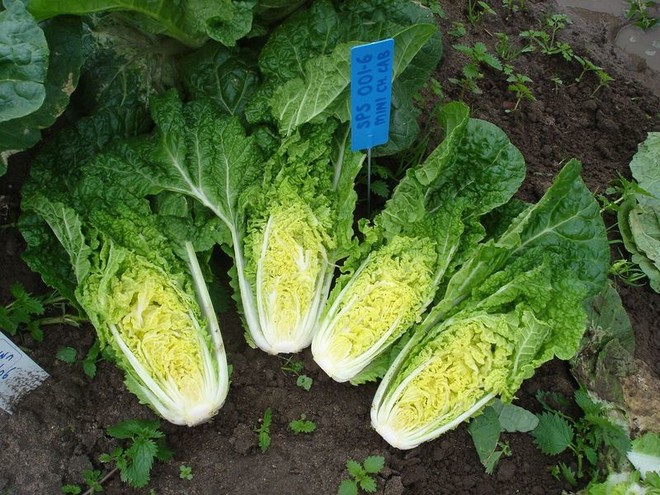
There are varietal and hybrid types of cabbage. The easiest to care for are hybrids that are bred by crossing several varieties for the best performance. Hybrids tolerate temperature fluctuations, are more disease resistant and resistant to blooming.
It is also recommended to choose early and medium varieties for planting. How long does Peking cabbage grow? Early ripening will allow harvesting within a month. The ripening period for medium varieties is approximately two months.
Seedling preparation
Planting Chinese cabbage in open beds can be done using seedlings or seeds. How to grow a crop is up to the grower himself. It is believed that if the seedlings are grown at home, then later development will take place at an accelerated pace.
For cultivation and care in the open field of Peking cabbage in the form of seedlings, the seeds can be planted on the 20th of March. If you intend to leave the vegetable for winter storage, then it is better to plant the seeds later.It is better to choose separate peat cups as a container, since the vegetable does not tolerate transplanting and picking (pinching the main root) well.
The plant feels good in soil made of humus with coconut substrate or turfy soil with peat. In the soil, make a depression equal to 1 cm. It is better to place two or even three seeds in the hole. This will increase the chances of germination. Then it is covered with a thin layer of soil, mulched with peat, covered with a bag and transferred to a dark place.
The first shoots should appear in three days. As soon as most of the planted seeds appear, the film is removed and the cups with sprouts are taken out to a lighted place. Do not forget about watering, you should not allow the formation of a dry crust.
When the first leaves appear, thinning is carried out. The strongest sprout is left, the rest are pinched, but not pulled out by the root. As soon as 5 leaves appear, the seedlings are ready for transplanting.
Growing options
How to grow Chinese cabbage outdoors using ready-made seedlings? In the spring, before planting seedlings, it is recommended to add a herbicide (Tornado, Default, Announce, Typhoon) to the ground. The herbicide is used only with a strong weed attack.
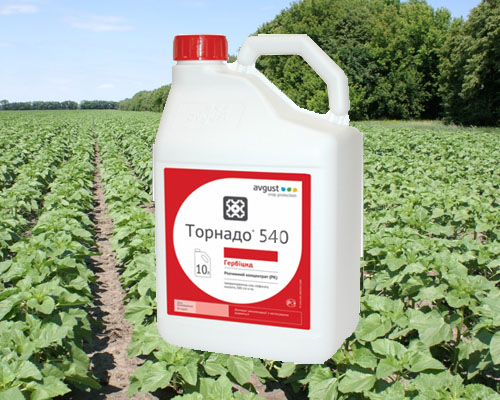
Holes are made in open beds. The size depends on the destination of the finished crop. If it is necessary to collect the leaves for salad, then pits in the furrow are made at a distance of 13 cm deep equal to the size of the cup. The row spacing should be approximately 45 cm.If heads of cabbage are to be harvested, the distance between the grooves in the furrow increases to 35 cm.
The specificity of planting seedlings is the introduction of fertilizers into each deepening made. You can make a composition from superphosphate, wood ash and urea. All these components are mixed with earth and watered. You can place young seedlings together with a peat pot in the prepared hole.
After planting, watered and protected from adverse weather for about 12 days with non-woven materials, until the plant takes root.
How to grow Peking cabbage in the country if seeds are planted in the ground right away? In the selected area, every 25 cm, recesses of 2 cm are made. It is useful to add humus, wood ash and water abundantly in them. Place two or three seeds in each well. After about five days, shoots appear and thinning is carried out, leaving the strongest shoot.
From the experience of gardeners who have been growing vegetables for more than one year, it can be judged that any method, with proper care, will give a good result. Galina, 43 years old: “For many years I have been planting cabbage with seeds at once in open beds. I will definitely provide shade, mulch the soil and apply fertilizers. "
Care rules
Peking cabbage agrotechnics must be carried out in accordance with all the rules. 12-14 days after planting cabbage seedlings, it is recommended to carry out the mulching procedure. Straw, sawdust, peat, fresh herbs are suitable as mulch. Moisture will be retained in the soil, there will be less weeds. Weeds can be treated with a herbicide.
Watering Chinese cabbage is enough once every seven days, early in the morning or in the evening, with warm, settled water. Irrigation is carried out at the root; moisture must not be allowed to enter the leaves.
The peculiarities of cultivation of Peking cabbage also include a mandatory loosening procedure. To prevent the formation of a crust on the soil during the entire growing season, it is necessary to carry out 3-4 loosening with a depth of 3 cm.After rain, you can conduct a deeper loosening.
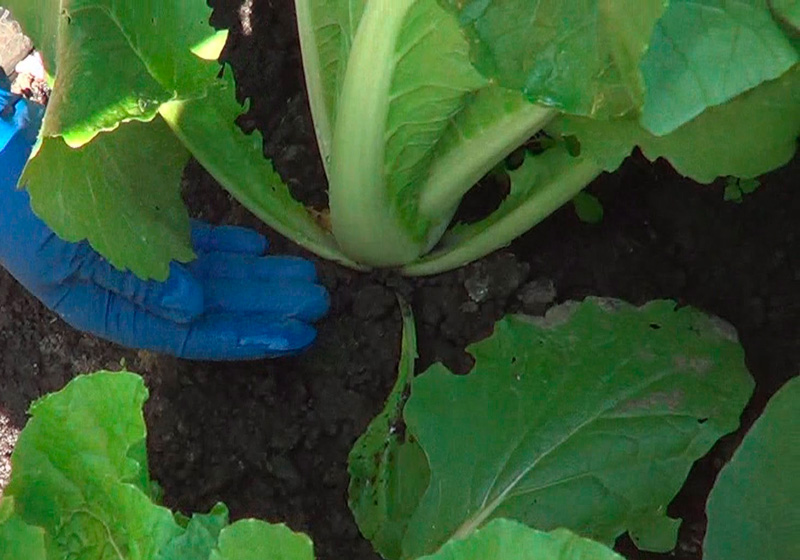
Peking cabbage care is carried out with mineral and organic fertilizers. Manure, bird droppings or herbal infusions are widely used as a top dressing for Peking cabbage, which is applied 12 days after transplantation. They allow you to enrich the soil with nutrients and protect plants from diseases.If the planting material was originally planted in well-fertilized beds, then additional feeding is not required.
Whether it is necessary to pick off the leaves of Peking cabbage depends on the appearance. If they change color and become deformed, then it is better to cut it off carefully so that other leaves do not get infected.
Do I need to huddle Chinese cabbage? Some gardeners bypass this procedure, believing that it is useless and even harmful for this plant. Those who spud the plant leave only positive reviews. The head of cabbage ripens faster and is protected from pests. Hilling should be carried out three weeks after planting the seedlings. Then the hilled bush needs to be loosened around. At this stage, the plant is fed with nitrogen components. It is imperative to get rid of weeds.
Sparing conditions
How to care for a vegetable in a polycarbonate greenhouse? Cultivation of Chinese cabbage in a greenhouse can also take place as a seedling option, or you can sow seeds immediately. If there are a lot of weeds in the greenhouse, a herbicide can be used.
The greenhouse crop can be harvested in 26 days. Harvesting is recommended early in the morning or before use, as it withers quickly.
In the greenhouse, cultivation is carried out at a temperature of 17 degrees. If seeds are planted, then until sprouts appear, the temperature rises to 20 degrees. As it strengthens and develops, it can be reduced to 10 degrees.
Growing rules include a clause that takes into account the regulation of the flow of light to the beds. If this is not done, arrows will move quickly. Therefore, a shaded frame is installed.

Peking cabbage is not resistant to diseases and pests. Therefore, it is necessary to grow Peking cabbage in a greenhouse, observing preventive measures. For this purpose, it is better to use natural ingredients. For example, wood ash. Since cabbage has a short ripening period, the use of chemicals will accumulate toxins in the head of cabbage.
In the event of a massive outbreak of pests that spread disease, pesticides may be used (Fury, Bankol). The cultivated culture is watered or sprayed with the preparation diluted according to the instructions.
How to grow Chinese cabbage at home? One of the conditions is the selection of high-quality and suitable soil. It should be light, fertile, not sour or greasy. A mixture of peat, sand and turf is ideal. You can use coconut substrate.
How to grow Chinese cabbage at home? Growing should take place on a windowsill in large pots so that the roots feel free. The container is disinfected, for example, with a solution of potassium permanganate and holes are made so that water does not stagnate.
Disembarkation period falls around mid-April, when daylight hours are still short. If at this time it did not work out to land, then they leave until mid-August.
Growing at home involves placing 3 seeds in a triangle in one pot with a volume of 3 liters. If the volume of the pot is 1-1.5 liters, then one seed is planted. Pre-moisten the soil and make holes 1 cm deep. After that, cover the containers with foil and place in a dark place. The first shoots should appear after 6 days. The film is removed and transferred to the windowsill. The culture does not require additional lighting.
FAQ
Knowing why Beijing cabbage is not tied, you can decide what to do to correct the situation. There are several reasons:
- a warm climate or too bright a sunny day (if the days are too long and hot, it is recommended to additionally shade the beds so that a head is tied up);
- cabbage loves watering, but not frequent watering, otherwise it can lead to rotting of the core;
- heads of cabbage may not be tied due to the fatty composition of the soil;
- in addition, the beds must not be thickened and thinning is carried out in a timely manner.

Many, especially beginners, are worried about the question, why does Beijing cabbage bloom? Heads of cabbage are tied only with a certain amount of daylight. Therefore, it is planted in early spring or late summer. The sprout first forms a rosette of leaves, and only then the head begins to form. As soon as its weight exceeds 2 kg, the risk of flowering and the appearance of an arrow increases. A lot of light can provoke flowering and the air temperature is more than 22 degrees.
Should the lower leaves of the plant be cut off? Heads of cabbage form quickly and are not too dense. It is necessary to tear off the leaves only when they have undergone decay or disease, which is extremely rare. Therefore, answering the question whether it is possible to pick off the leaves, the answer is yes. But this is not necessary.
When to harvest ripe heads of cabbage? The first crop can be harvested when the leaves are about 10 cm. You can pull out the plant along with the roots or cut only the leaves. You can wait for the head of cabbage to form (about two months), it should weigh about 1 kg.

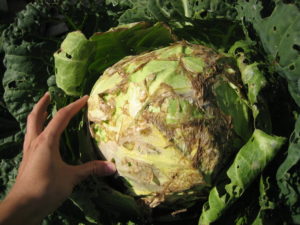
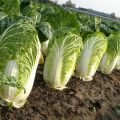

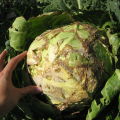
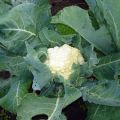
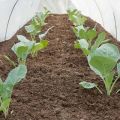
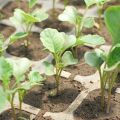
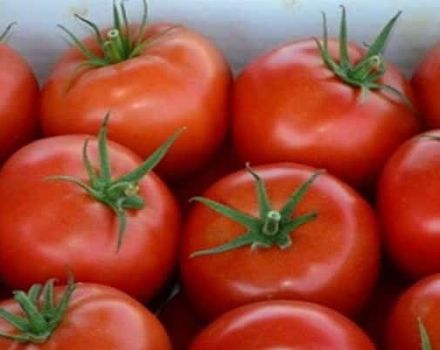
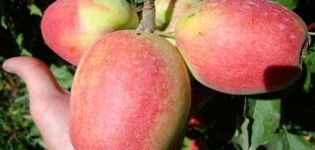
This year my Peking was not ugly. Poorly tied, it turned out nonsense, not cabbage. I think that the reason is the wrong fertilization. A friend used the BioGrow plant growth bioactivator, boasted about the harvest, but she has a completely different soil area, so I doubt that this tool contributed to the harvest. Next year I will try the tips from the article. I bought it in this store.